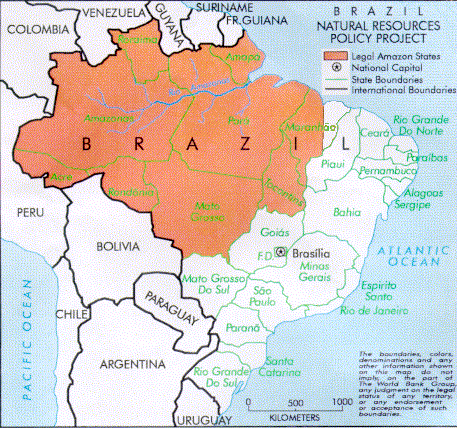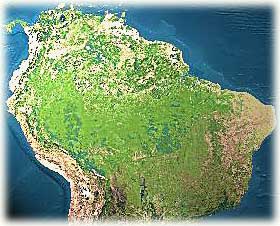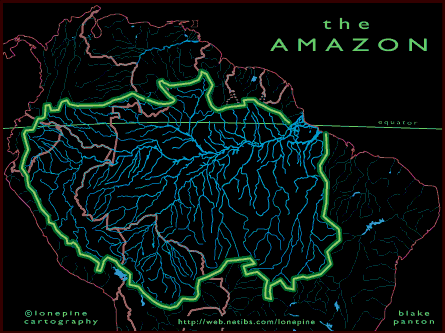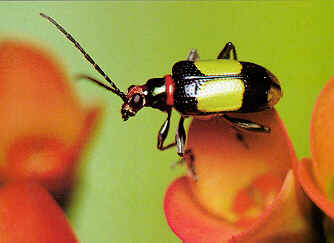
The only imperfect thing in nature is the human race.




The Amazon (mouth) its discovery by Vicente Yáñez Pinzón in 1500 and
called by him Marañón. It was named after the Amazons of Greek mythology.
In Greek mythology, the Amazons were a race of women warriors who lived in
Anatolia and fought with the Trojans against the Greeks in the Trojan-War. At
that time, their queen was Penthesileia, who was eventually killed by the Greek
hero Achilles (the conquerors believed to inhabit its shores a tribe of female
warriors); others insist the name is derived from the Indian word
amassona ("boat destroyer"). In 1540-41, an expedition led by Francisco
de Orellana started down the Napo River, in what is now Ecuador, and reached the
Atlantic Ocean.
The Amazon runs from the Andes Mountains in Peru through
Brazil to the Atlantic Ocean. This body of water is fed by about 15,000
tributaries and other bodies of water, by heavy tropical rains, and by the
melting snow of the Andes. The major headstreams of the Amazon are the Ucayali
and Marañón rivers, both of which rise in the permanente snows and glaciers of
the high Andes Mountains and flows parallel courses N before joining near Nauta,
Peru. From this confluence the main trunk of the Amazon flows in a generally E
direction to the Atlantic Ocean. Here delta deposits have formed a maze of
islands that separate the river into branches. The mouth of the main stream is
80 km wide. This branch, known as the Pará, is separated from a smaller branch
by Marajó Island, which has an area of more than 36,000 sq km. During new and
full moon a tidal bore, or wave front from the ocean, sweeps some 650 km
upstream at speeds in excess of 65 km/hr. This phenomenon (Pororoca)
often causes waves up to 5 m in height.
This massive river flows at an
approximate rate of 5 km/hr. The Amazon contains more water than any other river
in the world. The mouth of the Amazon River is approximately 160 km wide, and
discharge in one second more than 200,000 cubic meters per second of water into
the sea, is 6,450 km (4,000 mi) long and is the second- longest river in the
world after the Nile (Egypt). In 1994, however, a Peruvian research team
declared that the river's true source was the Ucayali River, not the Marañón,
which may make the Amazon the longest river in the world.
The rainy season in
the Amazon extends from November to June, and brings with it tremendous ammounts
of water. As much as ten feet of water per year is measured in some places. This
enourmous volume is a result of the humid tropical climate that caracterizes
most of the basin: the mean anual temperature is 26 degrees C (79 degrees F).
The rainfall is caused by the "respiration" of dense Amazonian forest which
release large quantities of water vapor into the atmosphere. One sixth of the
world's ocean runoff is from the Amazon Basin alone. Flooding on the Amazon
River is extremely common and an integral part of the Amazonian environment.
Brush, log, and sediment buildup cause flooding along the lower areas of the
Amazon during several months of the year. This carries fertile sediment great
distances and allows for the growth of dense tropical forests.
Different
regions of the Amazon River can be distinguished by their many color variations.
Much of the water is a chocolate brown color, due to all the sediment and debris
deposited in the river during the rainy season. It's currents are among the
cleanest of any major river in the world. Extremely dark areas are caused by an
abundance of organic matter found in the river system . The largest tributary of
the Amazon River, is a 2,253 km-long black-water river (Rio Negro) that begins
as the Guainia River in eastern Colombia, flowing east, then south along the
bordes of Venezuela and Colombia. It flows into Brazil as the Rio Negro and
joins the Amazon south of Manaus. Of the chief tributaries, the Negro, Japurá,
Putumayo, Napo, Ucayali, Juruá and Purus are also naviglabe for long distances.
Rivers remain the chief means of transport.
Typically, the Amazon Basin
receives around 1945 mm of rainfall (613 to 3,309 mm), equivalent to 13,303
cubic km of water. Approximately 1,166 mm (60%) of this amount recycles by
evapo- transpiration (437 to 1,718 mm), and 778 mm (40%) ends as streamflow (0
to 2,122) feeding the Amazon River. About 5,324 cubic km of fresh water is
delivered annually at an average rate of 168,831 cubic m/seg to the Atlantic
Ocean. Since this atmospheric water budget is based on typical conditions of
rainfall, and most of the time it does not occur throughout the Amazon Basin.
All types of vegetation in the Amazon Basin recycle around 60% of the available
water from rainfall.

Amazon Basin - South America |

Hidrographic Amazon
Map |

Rain forests may be grouped into two major types: tropical and
temperature. Tropical rain forest is characterized by broadleaf evergreen trees
that form a closed canopy, below which is found a zone of vines and epiphytes
(plants growing on the trees), a relatively open forest floor, and a very large
number of species of both plant and animal life. The largest trees have
buttressed trunks and emerge above the continous canopy, while smaller trees
commomly form a layer of more shade-tolerant species beneath the upper canopy.
The maximum height or the upper canopy of tropical rain forest is generally
about 30 to 50 m, with some individual trees rising as high as 60 m above the
forest floor. The Amazon rain forest covers an area 12 times de size of France
and is home to mores species of plants and animals than anywhere else on
earth.
The rain forest covering the vast Amazon River basin looks from the
air like a uniform green carpet cut here and there by water. Actually the forest
is anything but uniform. The "carpet" is the forest's canopy, formed by broad
leaves of many different kinds of giant trees, and this canopy is but the
topmost layer of an ecosystem supporting more species than any other region on
earth. The rain forest is home to perhaps 80,000 plant species (including 600
kinds of palm alone) and possibly 3 million animal species, most of them
insects.


AMAZON WILDLIFE
The Amazon Basin is home to more than 2 milion insect species, 100,000
plants, 2,000 species of fish, and 600 mammals, many of which are found nowhere
else in the world.
The newly (June 1996) identified monkey (mico anão/dwarf
cebus), no bigger than a squirrel, is the sixth primate species discovered by
scientists in Brazil in the last six years. Of 250 known monkey species, 75 are
in Brazil.
|
|
|
|
|
|
|
|
|
|
|
|
|
|
|
|
|
|
|
Sussuarana (Puma) |
|
|
|
|
|
|
|

AMAZON PICTURES
|
|
|
|
|
|
|
|
|
